![]()
![]()
![]()
Use LEFT and RIGHT arrow keys to navigate between flashcards;
Use UP and DOWN arrow keys to flip the card;
H to show hint;
A reads text to speech;
30 Cards in this Set
- Front
- Back
|
Function of Ingredients
Proteins |
Comprised of carbon, hydrogen, oxygen, and nitrogen (amino acids); amino acids are linked via peptide bonds to form large protein molecules.
|
|
|
Denaturation
|
unfolding of the large protein molecule (due to heat or mechanical stirring).
|
|
|
Coagulation
|
broken down (denatured) protein molecules bind together to form a solid mass (ie: fried egg).
|
|
|
Function of Ingredients
Fats |
Comprised of carbon, hydrogen, and oxygen; fats function as tenderizers in baked goods; for more information on fat functions review Module 1
|
|
|
Caramelize
|
browning when sugar is heated.
|
|
|
Maillard reaction
|
browning due to combination of an amino group of a protein and carbonyl group of a sugar (ie: browning of loaf of bread when baking).
Tenderize starch gel and stabilize egg white foam. |
|
|
Function of Sugar
|
Functions of Sugar
Caramelize Maillard reaction Tenderize starch gel and stabilize egg white foam. Provide crystalline structure in candy; occurs when solution is supersaturated - affected by type of solution, stirring or agitation, temperature, and whether impurities are present; formation is increased through agitation and the mixture of sugar with an acid. |
|
|
Brown sugar
|
contains sucrose crystals and molasses.
|
|
|
Corn syrup
|
made by using acid and high temperatures to hydrolyze corn starch
|
|
|
Granulated sugar
|
several granulations of refined sugar are available.
|
|
|
Honey
|
flower nectar collected, modified, and concentrated by honeybees; honey should not be given to infants or those with a compromised immune system due to honey potentially containing spores which can lead to botulism in these people.
|
|
|
Effects of Techniques and Methods on Aesthetic Properties
|
Taste/flavor – a variety of flavors should be offered at a meal; flavors should be balanced such as bland foods with spicy foods.
Variety – food and preparation technique should also vary; avoid serving foods that are all fried, all starches, or all of same texture; vary temperature and textures in a menu as well to offer variety. Visual – color and texture should vary; all soft foods or all one color foods may not look as appealing as a variety of textures or colors to the eye. |
|
|
Effects of Techniques and Methods on Nutrient Retention
|
Heat causes water soluble vitamin losses. Oxidation can lead to fat soluble vitamin losses (when exposed to the air). Drying and fermenting causes little nutrient losses. When microwaving, nutrient retention is increased due to shorter cooking time. Canning and freezing of processed foods leads to less nutrient losses than fresh unprocessed foods held for several days. For maximal nutrient consumption, cooking liquids should be consumed as well.
|
|
|
Food Additives
|
are substances not normally consumed as foods but added to food. The FDA oversees which additives may be added to foods. The additive must be effective, detectable and measurable in the final product, and safe. Some additives are added to GRAS (or generally recognized as safe) because they are safe to be used under certain conditions.
|
|
|
Antioxidants (Additive)
|
prevent changes in foods such as damage of food’s appearance, flavor, nutritional quality due to oxygen exposure. (eg: sodium ascorbate, vitamin E, sulfites, BHA, BHT, ascorbic acid).
|
|
|
Artificial colors
|
provide characteristic colors to food. (eg: caramel, citrus red no.2, dehydrated beets, yellow no. 5, paprika)
|
|
|
Artificial flavors and flavor enhancers
|
largest group of additives. (eg: MSG, extracts, herbs, vanilla, spices).
|
|
|
Emulsifiers (Additive)
|
aid keeping liquids mixed such as salad dressing (eg: lecithin, mono and diglycerides, polysorbates).
|
|
|
Leavening agents
|
aid in making foods lighter in texture and increasing volume. (calcium phosphate, monocalcium phosphate, sodium bicarbonate).
|
|
|
Stabilizers and thickeners
|
aid in maintaining uniform flavors and textures to keep desired consistency. (cellulose, gelatin, guar gum, pectin).
|
|
|
Vitamins and minerals (Additive)
|
added to restore nutrients lost during processing or to improve nutrient content of food. (carotene, iron, vitamin C, riboflavin, etc.).
|
|
|
Contamination
|
impurities within a substanc
|
|
|
The following aids in reducing risk for contamination:
|
Store foods at proper temperatures.
Use separate cutting boards for meats, raw fruits and vegetables, and raw and cooked foods. Keep foods out the danger zone (the danger zone is temperatures between 41 degrees F and 135 degrees F). Thaw frozen foods in refrigerator. Use eggs with intact shells; do not eat raw eggs. Do not reuse disposable containers. Wash fruits and vegetables immediately prior to using. Cover cuts with clean bandages prior to food preparation. Do not buy or use items that have broken seals or bulging sides. |
|
|
Macronutrients
|
are required by the body in larger amounts (carbohydrates, fats, protein, and water).
|
|
|
Micronutrients
|
are required by the body in smaller amounts (vitamins and minerals).
|
|
|
Phytochemicals
|
are compounds found in plant foods that are not nutritionally required but may offer health benefits.
|
|
|
Allium compounds
|
found in plant foods such as garlic and onion; may help to lower cholesterol and blood pressure.
|
|
|
Carotenoids
|
examples include lycopene or lutein; lycopene is found in plant foods such as tomatoes and lutein is found in green leafy vegetables and broccoli; may act as antioxidants.
|
|
|
Flavonoids
|
xamples include quercetin; found in plant foods such as strawberries and cherries may block carcinogens or inhibit cancer growth.
|
|

|

|

